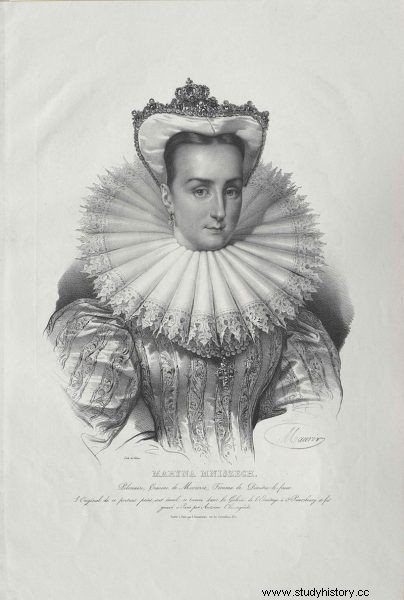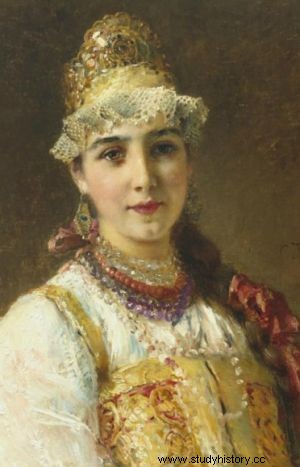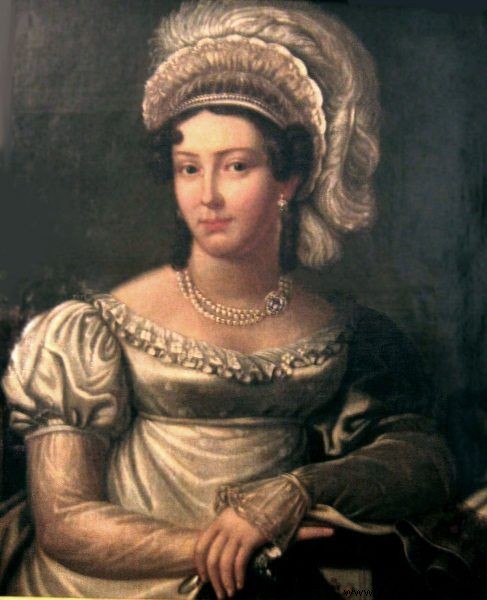Fate wanted these Polish women to find themselves in the very center of Russia's rule. Thanks to their extraordinary personalities, the history of Russia, and even of Europe and the world, took a different course.
The history of our compatriots in the Kremlin covers the period from the 17th to the 20th century. In the course of several hundred years, Russia made its way from a backwater state to an empire. Europeanization has affected every sphere of life in Russia except for one - the social position of women. Even her body did not belong to her - if a Romanov man wanted to make her his misfortune, the woman had to consider it a great honor and submit. The woman had to have a lot of courage and self-confidence to oppose the patriarchal principles prevailing in this world. Among the bold women there were also Polish women.
Maryna Mniszchówna (1588-1614)
She was the first Polish woman on the Russian throne, and the first crowned tsarina. She became the wife of one of the most mysterious characters - Dmitri the Samozwaniec who claims that he is the miraculously surviving son of Ivan the Terrible. In fact, it was a certain Grigory Otriepjew, who wanted to regain the throne of his alleged ancestors and sought support in Poland. The Russian managed to convince the voivode of Sandomierz, Jerzy Mniszch, of his tsarist origin. The cunning Pole quickly saw the opportunity:in return for his support, Dimitri pledged to marry Maryna Mniszchówna and make her a Moscow Tsarina.
So it happened, and on May 18, 1606, in the Kremlin, the Tsar of Moscow, Dmitri, married a Polish noblewoman, who was then crowned. The monarchs amazed the Russians with her European attire, naively thinking that in this way she would gain the favor of her subjects. In fact, the Muscovites blamed her for not respecting their traditions. The Polish woman used a fork so far unknown in Russia at the table, which the devout Russians considered a devil's tool.

Maryna Mniszchówna
Maryna's reign lasted only 9 days, because her husband was murdered by political opponents. The Polish woman was sent to Jarosław. When there was an opportunity to leave for her homeland, Mniszchówna, who took great pleasure from being a tsarina, decided to stay in Russia. She hoped that her fate would change and that she would put on the crown again ("Being the mistress of nations, the Moscow Tsar ... I cannot be a subject again and return to the state of a Polish noblewoman" - declared the woman). This is how a woman politician was born.
Therefore, when an individual claiming to be the surviving Tsar Dmitri appeared in Staroduba, Maryna saw her chance to regain power and considered him her murdered husband. She bore him a son and accompanied him on an expedition to Moscow. After the death of her alleged spouse, the Polish woman became involved with the Cossack ataman Zarucki, who undertook to place her son on the Russian throne.
However, a defeat awaited Mniszchówna:she, her partner and the child were arrested by the government troops. The man and the boy were executed, Maryna was sent to Kolomna and imprisoned in the local Kremlin, where in the spring of 1615 the woman mysteriously died.
Agafia Gruszecka (1663-1681)
She can be considered the first Russian feminist and pioneer of the reforms of Peter I . In her early childhood, Miss Gruszecka promised to be an extraordinary woman. Unlike her Russian peers, who did not receive any education, Agafia was able to read and write thanks to her father, Semyon, the voivode of the town of Chernavsk (now in the Lipetsk Oblast). She played the harpsichord, understood French, although she could not speak it. Apparently, a widow from Warsaw was brought for her to learn good manners.
Agafia dressed - as it was then called - "in the Polish fashion" . She wore dresses with a low neckline, although in Moscow Ruthenia only harlots wore an open neck. She was not wearing ghost-repellent necklaces. She also wore a so-called Polish cap revealing her hair at the roots and sides, although it was customary to hide it even from family members.
It was Agafia's outfit, unusual for Russian conditions, that attracted the attention of 19-year-old Tsar Fyodor III (1661-1682), who saw the girl in the church on Palm Sunday. The monarch was also captivated by the beauty of the girl:tall, feminine shapes, blue eyes, and a prominent chest. He wanted to marry her and got his way, ignoring the protests of the courtiers, for whom Miss Gruszecka's emancipation was a huge disadvantage.

Agafia Gruszecka
Tsar Fyodor, the elder brother of Peter I, saw his wife's progressiveness as an advantage, as he began reforms in Russia. Agafia not only supported her husband, but also contributed to changes in the courtly fashion. At the urging of a Polish woman, the monarch ordered his courtiers to wear European costumes and cut their hair and beards , although the latter is wrongly attributed to Piotr I. Agafia's sisters-in-law began to wear Polish hats, and - thanks to the intervention of the young tsarina - they were given the right to ... choose dishes that had been denied them earlier.
The Polish woman - unlike her predecessors hiding behind the thick walls of the Kremlin - began to appear in public and even received foreign ambassadors together with her husband . Unfortunately, the rule of progressive Agafia lasted just over a year - the woman died after giving birth to her son.
Joanna Grudzińska (1795-1831)
Unlike Maryna and Agafia, Countess Grudzińska never had any political ambitions. Nevertheless, she made Grand Duke Konstanty, commander of the Polish army and de facto ruler of the Kingdom of Poland, relinquish his rights to the crown in order to marry a Polish woman.
Romanow, then 36, met Joanna in Warsaw, at a ball at governor Zajączek in 1815 and it was love at first sight. Marriage was out of the question because many of the prince was married, although he had been separated from his wife since 1801. In addition, the Imperial Family Act required men of the Romanov family to marry princesses from ruling families, and Joan was "merely" a countess!
Konstanty undoubtedly desired Miss Grudzińska, but the Polish woman did not agree to extramarital sex. And the man respected her decision, although before that he had just taken by force the women he liked. In fact, the families of these unfortunates thought that having cohabitation with a member of the tsarist family was an honor!

Joanna Grudzińska
Joan became a forbidden fruit for the great prince, for which he argued with his own family. He fought until his mother and brother, Alexander I, consented to divorce and remarry. The price for the marriage with the Countess was the waiver of the rights to the crown, which Konstanty did without hesitation.
Joanna and Konstanty got married on May 24, 1820. Their family life was idyllic, and the Grand Duke continued to rave about his wife in letters to family and friends: “I am happy in my home life. The main cause of this is my wife. ” In public, he emphasized her influence on his behavior:“Here is a Polish woman who civilized me. Before marrying her, I was an ordinary Russian bear. ”
The article was based on the materials collected for the book
- Wiernicka Violetta., Polish women who ruled the Kremlin. Bellona, 2018
